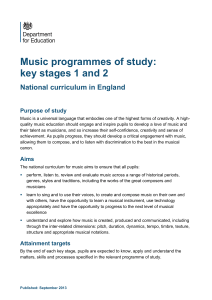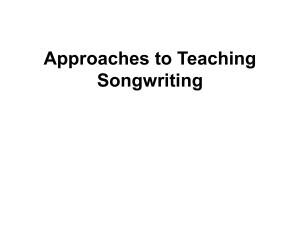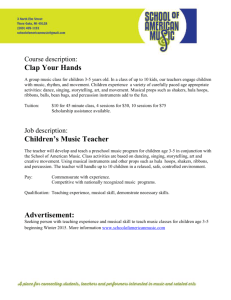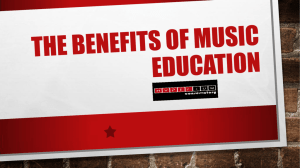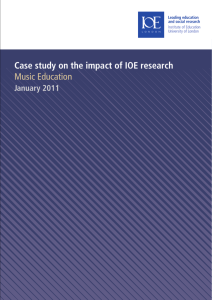Music Bookmark 2014
advertisement
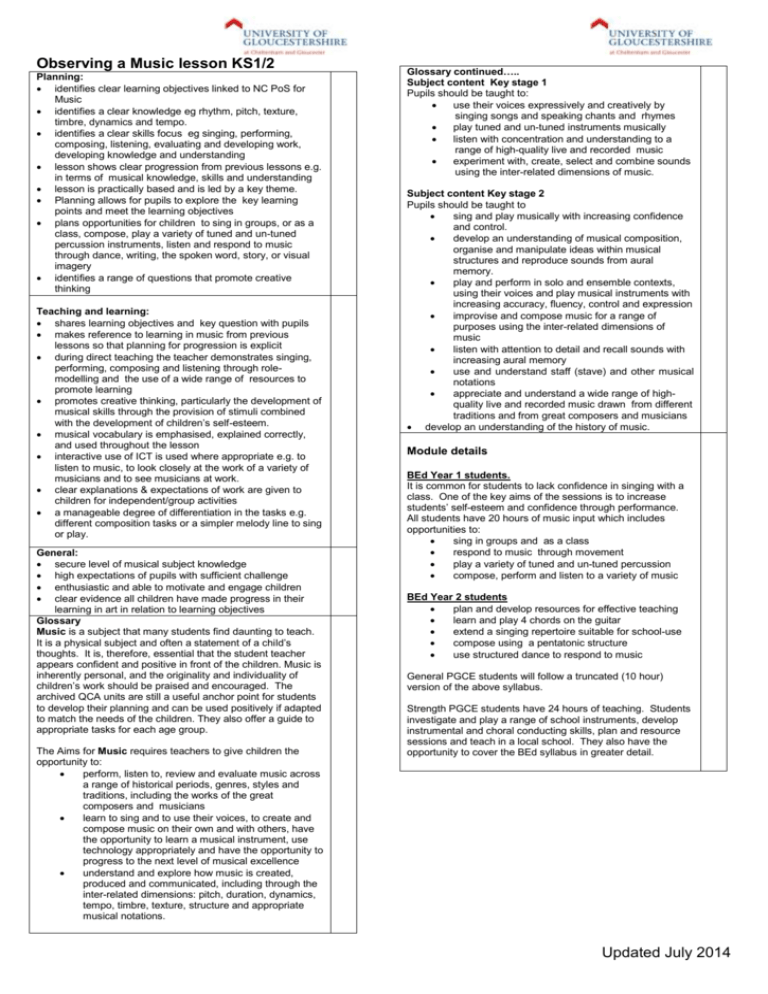
Observing a Music lesson KS1/2 Planning: identifies clear learning objectives linked to NC PoS for Music identifies a clear knowledge eg rhythm, pitch, texture, timbre, dynamics and tempo. identifies a clear skills focus eg singing, performing, composing, listening, evaluating and developing work, developing knowledge and understanding lesson shows clear progression from previous lessons e.g. in terms of musical knowledge, skills and understanding lesson is practically based and is led by a key theme. Planning allows for pupils to explore the key learning points and meet the learning objectives plans opportunities for children to sing in groups, or as a class, compose, play a variety of tuned and un-tuned percussion instruments, listen and respond to music through dance, writing, the spoken word, story, or visual imagery identifies a range of questions that promote creative thinking Teaching and learning: shares learning objectives and key question with pupils makes reference to learning in music from previous lessons so that planning for progression is explicit during direct teaching the teacher demonstrates singing, performing, composing and listening through rolemodelling and the use of a wide range of resources to promote learning promotes creative thinking, particularly the development of musical skills through the provision of stimuli combined with the development of children’s self-esteem. musical vocabulary is emphasised, explained correctly, and used throughout the lesson interactive use of ICT is used where appropriate e.g. to listen to music, to look closely at the work of a variety of musicians and to see musicians at work. clear explanations & expectations of work are given to children for independent/group activities a manageable degree of differentiation in the tasks e.g. different composition tasks or a simpler melody line to sing or play. General: secure level of musical subject knowledge high expectations of pupils with sufficient challenge enthusiastic and able to motivate and engage children clear evidence all children have made progress in their learning in art in relation to learning objectives Glossary Music is a subject that many students find daunting to teach. It is a physical subject and often a statement of a child’s thoughts. It is, therefore, essential that the student teacher appears confident and positive in front of the children. Music is inherently personal, and the originality and individuality of children’s work should be praised and encouraged. The archived QCA units are still a useful anchor point for students to develop their planning and can be used positively if adapted to match the needs of the children. They also offer a guide to appropriate tasks for each age group. The Aims for Music requires teachers to give children the opportunity to: perform, listen to, review and evaluate music across a range of historical periods, genres, styles and traditions, including the works of the great composers and musicians learn to sing and to use their voices, to create and compose music on their own and with others, have the opportunity to learn a musical instrument, use technology appropriately and have the opportunity to progress to the next level of musical excellence understand and explore how music is created, produced and communicated, including through the inter-related dimensions: pitch, duration, dynamics, tempo, timbre, texture, structure and appropriate musical notations. Glossary continued….. Subject content Key stage 1 Pupils should be taught to: use their voices expressively and creatively by singing songs and speaking chants and rhymes play tuned and un-tuned instruments musically listen with concentration and understanding to a range of high-quality live and recorded music experiment with, create, select and combine sounds using the inter-related dimensions of music. Subject content Key stage 2 Pupils should be taught to sing and play musically with increasing confidence and control. develop an understanding of musical composition, organise and manipulate ideas within musical structures and reproduce sounds from aural memory. play and perform in solo and ensemble contexts, using their voices and play musical instruments with increasing accuracy, fluency, control and expression improvise and compose music for a range of purposes using the inter-related dimensions of music listen with attention to detail and recall sounds with increasing aural memory use and understand staff (stave) and other musical notations appreciate and understand a wide range of highquality live and recorded music drawn from different traditions and from great composers and musicians develop an understanding of the history of music. Module details BEd Year 1 students. It is common for students to lack confidence in singing with a class. One of the key aims of the sessions is to increase students’ self-esteem and confidence through performance. All students have 20 hours of music input which includes opportunities to: sing in groups and as a class respond to music through movement play a variety of tuned and un-tuned percussion compose, perform and listen to a variety of music BEd Year 2 students plan and develop resources for effective teaching learn and play 4 chords on the guitar extend a singing repertoire suitable for school-use compose using a pentatonic structure use structured dance to respond to music General PGCE students will follow a truncated (10 hour) version of the above syllabus. Strength PGCE students have 24 hours of teaching. Students investigate and play a range of school instruments, develop instrumental and choral conducting skills, plan and resource sessions and teach in a local school. They also have the opportunity to cover the BEd syllabus in greater detail. Updated July 2014


